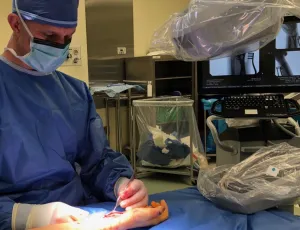By Starla S Collins of the Flagstaff Business News (Read Original Article)
After a traumatic accident at a Winslow sawmill, hours of surgery and months of physical and occupational therapy, 44-year-old Mickey Rosenquist can almost fully straighten and bend his arm and turn his wrist from side to side. To have his arm at all is the result of quick action by co-workers, first responders and a team of leading surgeons.
Rosenquist was hired to cut standing-dead trees and lumber into firewood to be sold at convenience stores. He was feeding the wood into the band saw. The next memory he had was experiencing “a very odd feeling.”
“I yelled at my coworker that my arm was gone,” recalled Rosenquist. “He thought I was joking. I yelled again and he realized I was serious. He sat me down, took off his belt and we used it for a tourniquet on my upper arm, then he ran 60 yards to the office to get help. I saw my arm laying a few yards away from me. When the paramedics arrived, they worked to stop the bleeding and called for a medical helicopter. My arm was placed in a clear plastic bag and tucked in beside me for the flight.”
Rosenquist was flown to the region’s only state-designated Level I Trauma Center at Flagstaff Medical Center (FMC). Fortunately, at least four of the country’s top surgeons work in Flagstaff.
Patrick Cole, M.D., is one of only a few who perform microsurgery (surgery at the “nano” level that requires special equipment and specialized training), as well as complex reconstructive surgery and plastic surgery. Dr. Cole is a physician member at the Plastic Surgeons of Northern Arizona.
This was not the first time Dr. Cole had performed such extensive surgery. In 2016, he did a successful hand replantation at FMC on a man whose hand was detached from an explosion.
Replantation is the surgical reattachment of a finger, hand or arm that has been detached from the body. In some cases, a replant is not possible because the body is too damaged or too much time has elapsed between injury and surgery. Rosenquist was a good candidate because the detachment was a “clean cut” and he was quickly transported to a trauma center.
Dr. Cole was joined by fellow Flagstaff surgeons Andrew Aldridge, M.D., Brandon Clark, D.O., and Mark Donnelly, M.D.
Dr. Aldridge specializes in all aspects of surgery, including trauma surgery. He was instrumental in the development of FMC’s Trauma Center and is part of the physician group at Flagstaff Surgical Associates.
Dr. Clark is an orthopaedic traumatologist. He specializes in orthopaedic trauma and adult post-traumatic injury reconstruction, which often includes numerous complex fractures. He is part of the physician group at Northern Arizona Orthopaedics.
Dr. Donnelly specializes in vascular and trauma surgery and was instrumental in the development of FMC’s Trauma Center and Heart & Vascular Center.
The surgeons worked together to perform the arm-saving surgeries, each bringing his expertise and training to the surgical table to repair bones, muscles, nerves, arteries and veins, all in an attempt to save the arm and restore function.
According to Dr. Cole, surgeons only have about six hours from the time of the injury to restore blood flow. Drs. Donnelly and Aldridge performed the first surgery, which took four hours.
Dr. Aldridge explained, “We needed to bring the greatest amount of blood flow back to the arm in the fastest time. We used small tubing, like that used for IVs, to create vessels to move the blood between the upper attached and lower detached arm. Without this immediate blood supply, the arm would not be able to be replanted.”
The following day, Drs. Clark and Cole performed a second surgery. Dr. Clark used grafts, plates, screws, pins, wires, shunts and more to reconnect the bones, muscles and other soft tissues. Dr. Cole performed microsurgery to reconnect the nerves, which are just one-quarter of the
diameter of a strand of human hair.
“We can restore blood flow and reconnect the bones, muscles and tissues, but the amount of movement is dependent on the nerves, which are the connection between the brain and the body,” Dr. Cole said. “Without nerve regeneration and connection to the brain, there is no muscle movement.”
The third surgery entailed removing a large vein from Rosenquist’s leg to repair, connect and create three veins and two arteries in the arm. Skin grafts were the final stage of the surgical replant process.
“The level of function Mickey has is unprecedented,” Dr. Cole said. “He has a great deal more use than expected. I attribute the success to an extraordinary team of physicians, nurses, first responders, therapists and support staff. And, of course, to Mickey, for his determination and steadfastness to make the best of the situation and do everything he was directed to do.”
Rosenquist is more than grateful to the first responders, surgeons and trauma team at FMC.
“I am so grateful to the four amazing surgeons who brought their expertise to the table, literally. Without them, all the people at the hospital and my physical and occupational therapists, I would not have an arm, much less some use of both my arm and hand. I am eternally grateful.” FBN

